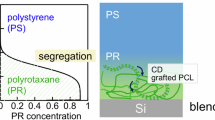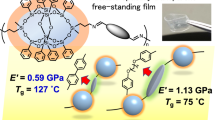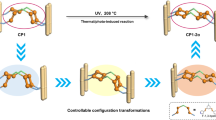Abstract
THE photo-elastic properties of polystyrene at temperatures above its softening point have been investigated earlier1,2, and it has been found that under these conditions the stress-birefringence is in the opposite direction from that found for most other materials. This is in agreement with the results reported by Signer3 on the flow-birefringence of polystyrene solutions. Signer pointed out that this behaviour would be expected if it is assumed that, when the molecular chains become aligned, the benzene rings orientate themselves at right angles to the direction of the chains; and, since the optical effect of the benzene rings is greater than that of the main chain, the net stress-birefringence will be negative.
This is a preview of subscription content, access via your institution
Access options
Subscribe to this journal
Receive 51 print issues and online access
$199.00 per year
only $3.90 per issue
Buy this article
- Purchase on SpringerLink
- Instant access to full article PDF
Prices may be subject to local taxes which are calculated during checkout
Similar content being viewed by others
References
Kolsky, H., and Shearman, A. C., Proc. Phys. Soc., 55, 383 (1943).
Nielsen, L. E., and Buchdahl, R., J. Chem. Phys., 17, 839 (1949).
Signer, R., Trans. Farad. Soc., 32, 296 (1936).
Author information
Authors and Affiliations
Rights and permissions
About this article
Cite this article
KOLSKY, H. Stress-Birefringence in Polystyrene. Nature 166, 235–236 (1950). https://doi.org/10.1038/166235b0
Issue date:
DOI: https://doi.org/10.1038/166235b0
This article is cited by
-
The optical birefringence of injection-moulded polystyrene and polyethylene
Journal of Materials Science (1989)
-
New model materials for photoelasticity and photoplasticity
Experimental Mechanics (1962)



